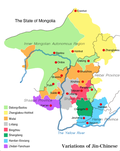Sinitic languages
The Sinitic languages, also called the "Chinese languages", are a branch of Sino-Tibetan languages spoken mainly in China. Some think there is a split between Sinitic languages and the rest of the family (Tibeto-Burman languages), but many researchers now do not agree with this.[1] Because of this, the Sinitic languages are simply Sino-Tibetan languages that are seen as varieties of Chinese. Many think Chinese is one language with many dialects, when it may be a group of different languages.[a]
| Sinitic | |
|---|---|
| Chinese | |
| Ethnicity: | Sinitic peoples |
| Geographic distribution: | China, Singapore, Malaysia, Taiwan |
| Linguistic classification: | Sino-Tibetan
|
| Subdivisions: | |
| ISO 639-5: | zhx |
Sinitic Languages Media
L1 speakers of Chinese and other Sino-Tibetan languages according to Ethnologue
After applying the linguistic comparative method to the database of comparative linguistic data developed by Laurent Sagart in 2019 to identify sound correspondences and establish cognates, phylogenetic methods are used to infer relationships among these languages and estimate the age of their origin and homeland.[3]
Notes
- ↑ See, for example, Enfield (2003:69) and Hannas (1997). The Chinese terms often translated as 'language' and 'dialect' aren't always correct. These are 語言 yǔyán, meaning to macrolanguage or language cluster, that is used for Chinese itself; 方言 fāngyáng, which separates mutually unintelligible languages within a yǔyán; and 土語 tǔyǔ or 土話 tǔhuà, which is closer to the word 'dialect'.[2]
References
- ↑ van Driem (2001), p. 351.
- ↑ Bradley (2012), p. 1.
- ↑ Sagart et al. (2019), pp. 10319–10320.
Sources
- Bradley, David (2012), "Languages and Language Families in China", in Rint Sybesma (ed.), Encyclopedia of Chinese Language and Linguistics., Brill
- van Driem, George (2001), Languages of the Himalayas: An Ethnolinguistic Handbook of the Greater Himalayan Region, Brill, ISBN 90-04-10390-2
- Enfield, N. J. (2003), Linguistics Epidemiology: Semantics and Language Contact in Mainland Southeast Asia, Psychology Press, ISBN 0415297435
- Hannas, W. (1997), Asia's Orthographic Dilemma, University of Hawaii Press, ISBN 082481892X









